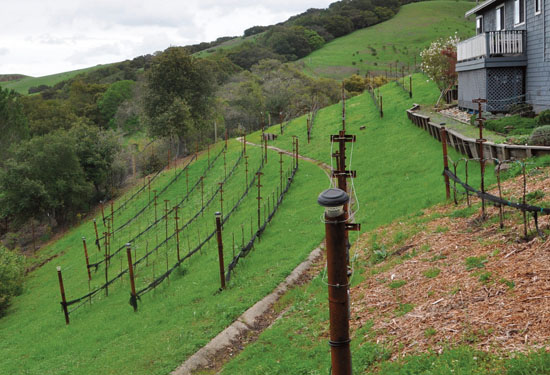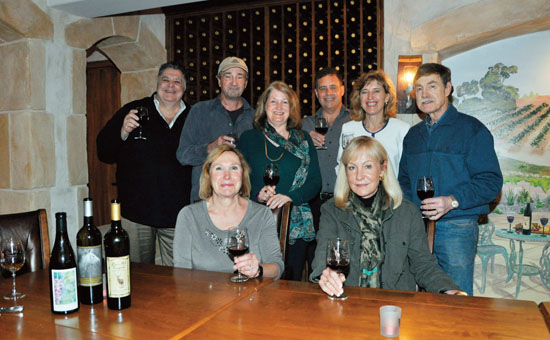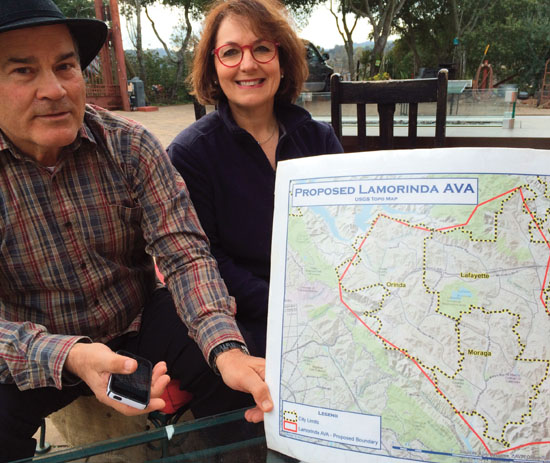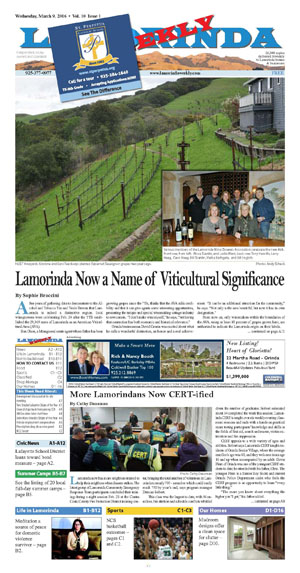|
|
Published March 9th, 2016
|
Lamorinda Now a Name of Viticultural Significance
|
|
| By Sophie Braccini |
 |
| NOET Vineyards. Kristiina and Eero Teerikorpi planted Cabernet Sauvignon grapes two years ago. Photos Andy Scheck |
After years of gathering data to demonstrate to the Alcohol and Tobacco Tax and Trade Bureau that Lamorinda is indeed a distinctive region, local winegrowers were celebrating Feb. 24 after the TTB established the 29,369 acres of Lamorinda as an American Viticultural Area (AVA).
 Ben Olsen, a Moraga real estate agent whose father has been growing grapes since the '70s, thinks that the AVA adds credibility and that it can give agents some interesting opportunities, presenting the unique and special winemaking cottage industry to newcomers. "I don't make wine myself," he says, "but having that connection has both economic and historical relevance."
Ben Olsen, a Moraga real estate agent whose father has been growing grapes since the '70s, thinks that the AVA adds credibility and that it can give agents some interesting opportunities, presenting the unique and special winemaking cottage industry to newcomers. "I don't make wine myself," he says, "but having that connection has both economic and historical relevance."
 Orinda businessman David Cronin was excited about what he calls a wonderful distinction, an honor and a real achievement. "It can be an additional attraction for the community," he says. "Not only is the area beautiful, but now it has its own designation."
Orinda businessman David Cronin was excited about what he calls a wonderful distinction, an honor and a real achievement. "It can be an additional attraction for the community," he says. "Not only is the area beautiful, but now it has its own designation."
 From now on, only winemakers within the boundaries of the AVA, using at least 80 percent of grapes grown here, are authorized to indicate the Lamorinda origin on their labels. Members of the Lamorinda Wine Growers Association (LWGA), which funded the study that was submitted to the TTB for approval, say that the AVA adds a sense of place, and puts Lamorinda in a bottle.
From now on, only winemakers within the boundaries of the AVA, using at least 80 percent of grapes grown here, are authorized to indicate the Lamorinda origin on their labels. Members of the Lamorinda Wine Growers Association (LWGA), which funded the study that was submitted to the TTB for approval, say that the AVA adds a sense of place, and puts Lamorinda in a bottle.
 "We felt that the existing AVAs did not describe our wines adequately," says LWGA Vice-President Carol Haag. "What we discovered during the study is that the actual city limits [comprising Lamorinda] match a unique geological region with its own climate and soil composition." The dominant geological formation, known as the Orinda Formation, supports most of Lamorinda, and the soils found in Lamorinda are a combination of uplifted sedimentary formations, some rich in marine fossils, and erosion from the surrounding mountains. These unique characteristics of the Lamorinda terroir, the natural environment in which a particular wine is produced, are favorable to great winemaking.
"We felt that the existing AVAs did not describe our wines adequately," says LWGA Vice-President Carol Haag. "What we discovered during the study is that the actual city limits [comprising Lamorinda] match a unique geological region with its own climate and soil composition." The dominant geological formation, known as the Orinda Formation, supports most of Lamorinda, and the soils found in Lamorinda are a combination of uplifted sedimentary formations, some rich in marine fossils, and erosion from the surrounding mountains. These unique characteristics of the Lamorinda terroir, the natural environment in which a particular wine is produced, are favorable to great winemaking.
 There are five bonded wineries currently within the Lamorinda AVA, each producing a few hundred cases per year. TTB identified 46 commercially producing vineyards covering approximately 139 acres in the Lamorinda AVA. The individual vineyards are small, people live where they grow their vines, usually covering less than 5 acres, sprinkled like confetti among the lower density housing areas of the three suburbs. Most of the vineyard owners either simply grow the grapes or make wine only for their family and friends. Not all are part of the LWGA.
There are five bonded wineries currently within the Lamorinda AVA, each producing a few hundred cases per year. TTB identified 46 commercially producing vineyards covering approximately 139 acres in the Lamorinda AVA. The individual vineyards are small, people live where they grow their vines, usually covering less than 5 acres, sprinkled like confetti among the lower density housing areas of the three suburbs. Most of the vineyard owners either simply grow the grapes or make wine only for their family and friends. Not all are part of the LWGA.
 None of the winemakers at this time make a fortune with their wineries. "One needs to produce 20,000 to 30,000 cases a year to make a living," says Sal Captain of Captain Vineyards in Moraga. But those who sell commercially have already won awards in regional wine competitions. The Lamorinda terroir is rich, the flavors are intense, and the colors deep. Now the new appellation is a way for East Bay connoisseurs to source truly local wines. "The diverse topology creates microclimates that allow many grape varietals to grow well in Lamorinda," adds Haag. "While there are some white wine varietals being grown, Lamorinda is mostly devoted to red wine varietals. Cabernet Sauvignon, Pinot Noir, Syrah, Petite Sirah and Sangiovese are most common. Being a relatively new winegrowing area, there is some experimentation going on with some very interesting results."
None of the winemakers at this time make a fortune with their wineries. "One needs to produce 20,000 to 30,000 cases a year to make a living," says Sal Captain of Captain Vineyards in Moraga. But those who sell commercially have already won awards in regional wine competitions. The Lamorinda terroir is rich, the flavors are intense, and the colors deep. Now the new appellation is a way for East Bay connoisseurs to source truly local wines. "The diverse topology creates microclimates that allow many grape varietals to grow well in Lamorinda," adds Haag. "While there are some white wine varietals being grown, Lamorinda is mostly devoted to red wine varietals. Cabernet Sauvignon, Pinot Noir, Syrah, Petite Sirah and Sangiovese are most common. Being a relatively new winegrowing area, there is some experimentation going on with some very interesting results."
 It took the LWGA three years to conduct the research and get the TTB approval. Haag said that in June of 2012 the group engaged the services of professors Patrick Shabram, Kenneth Verosub and Michael Oskin to perform the necessary research. "We were fortunate to get amazing support from the Livermore AVA," adds Susan Captain who was part of the AVA committee with Chair Dave Rey, Vlatka Bathgate, Tom Morehouse, Jim Ward and Bill English. Livermore's AVA is three times as large as Lamorinda's, which will be one of the smallest in the nation. The quantity of grapes grown here is likely to remain limited since both the cost of land and the pressure for more housing are quite high.
It took the LWGA three years to conduct the research and get the TTB approval. Haag said that in June of 2012 the group engaged the services of professors Patrick Shabram, Kenneth Verosub and Michael Oskin to perform the necessary research. "We were fortunate to get amazing support from the Livermore AVA," adds Susan Captain who was part of the AVA committee with Chair Dave Rey, Vlatka Bathgate, Tom Morehouse, Jim Ward and Bill English. Livermore's AVA is three times as large as Lamorinda's, which will be one of the smallest in the nation. The quantity of grapes grown here is likely to remain limited since both the cost of land and the pressure for more housing are quite high.
 The six bonded wineries allowed to sell commercially are Bullfrog Creek Vineyard in Moraga, Captain Vineyards in Moraga, Deer Hill Vineyards in Lafayette, Los Arabis Vineyards in Lafayette, Meadow View Winery in Orinda, and Vincenza Ranch in Moraga. "Lamorinda wines are sold at Cine Cuvee, The Cooperage, The Fourth Bore, Hideout Kitchen & Café, Lafayette Park Hotel, Postino, Walnut Creek Yacht Club, Amorama, Diablo Foods, Jacksons, Moraga Wine & Liquor and the Wine Thieves," says Haag. Wines can also be purchased online and at the individual wineries. For information, visit www.Lamorindawinegrowers.com.
The six bonded wineries allowed to sell commercially are Bullfrog Creek Vineyard in Moraga, Captain Vineyards in Moraga, Deer Hill Vineyards in Lafayette, Los Arabis Vineyards in Lafayette, Meadow View Winery in Orinda, and Vincenza Ranch in Moraga. "Lamorinda wines are sold at Cine Cuvee, The Cooperage, The Fourth Bore, Hideout Kitchen & Café, Lafayette Park Hotel, Postino, Walnut Creek Yacht Club, Amorama, Diablo Foods, Jacksons, Moraga Wine & Liquor and the Wine Thieves," says Haag. Wines can also be purchased online and at the individual wineries. For information, visit www.Lamorindawinegrowers.com.

|
 |
| Various members of the Lamorinda Wine Growers Association celebrate the new AVA. Front row, from left: Alissa Scanlin, and Leslie Ward; back row: Tony Inzerillo, Larry Haag, Carol Haag, Bill Scanlin, Vlatka Bathgate, and Bill English. |
 |
| Sal and Susan Captain showing the Lamorinda AVA map Photo Sophie Braccini |
|
|
|
|
| |
|
|
|
|






